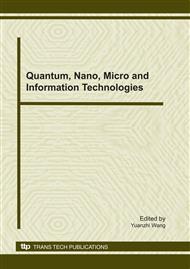[1]
Akamatsu, M., MacKenzie, S. I., and Hasbrouc, T. A Comparison of Tactile, Auditory and Visual Feedback in a Pointing Task using a Mouse-Type device,. Ergonomics 38: 816-827, (1995).
DOI: 10.1080/00140139508925152
Google Scholar
[2]
Accot, J. and Zhai, S. Beyond Fitts' Law: Models for Trajectory-Based HCI Tasks". In Proceedings of CHI, 97, 295–302.
DOI: 10.1145/1120212.1120376
Google Scholar
[3]
Al-Imam, E. and Lank, E. Biasing Response in Fitts' Law Tasks". In Proceeding CHI , 06 Extended Abstracts on Human Factors in Computing Systems, 460-465.
DOI: 10.1145/1125451.1125553
Google Scholar
[4]
Bootsma R. J., Marteniuk R. G. and Mackenzie, C. L., Zaal, F. T. J. M. The speed-accuracy trade-off in manual prehension: effects of movement amplitude object size and object width on kinematic characteristics,. Experimental brain research 98(3): 535-541, (1994).
DOI: 10.1007/bf00233990
Google Scholar
[5]
de Gőtzen, A. and Rocchesso D. Audio Feedback in Predictive HCI Methods,. In Proceeding SMC 2005, Salerno, Italy, 24-26 of November (2005).
Google Scholar
[6]
Dean, M., Wu, S. -W. and Maloney, L. T. Trading off speed and accuracy in rapid, goal-directed movements,. Journal of Vision 7(5): 10, 1-12, (2007).
DOI: 10.1167/7.5.10
Google Scholar
[7]
Elliott, D., Hansen, S., Mendoza, J. and Tremblay, L. Learning to Optimize Speed, Accuracy, and Energy Expenditure: A Framework for Understanding Speed-Accuracy Relations in Goal-Directed Aiming,. Journal of Motor Behavior 36(3): 339-350, (2004).
DOI: 10.3200/jmbr.36.3.339-351
Google Scholar
[8]
Fraser, J and Gutwin C. A Framework of Assistive Pointer for Low Vision Users". In Proceeding ASSETS , 00, 9-16.
Google Scholar
[9]
MacKenzie, I. S. and Isokoski, P. Fitts'. Throughput and the Speed-Accuracy Tradeoff". In Proceeding CHI , 08. 1633-1636.
Google Scholar
[10]
MacKenzie, I. S., Kauppinen, T. and Silfverberg, M. Accuracy Measures for Evaluating Computer Pointing Devices". In proceeding CHI , 01, 9-16.
Google Scholar
[11]
Marentakis, G. and Brewster, S. A. A Comparison of Feedback Cues for Enhancing Pointing Efficiency in Interaction with Spatial Audio Displays,. MobileHCI 111, 55-62, (2005).
DOI: 10.1145/1085777.1085787
Google Scholar
[12]
Osman A., Lou, L., Muller-Gethmann, H., Rinkenauer G., Mattes S. and Ulrich R. Mechanisms of speed-accuracy tradeoff: evidence from covert motor processes,. Biological Psychology 51: 173-199, (2000).
DOI: 10.1016/s0301-0511(99)00045-9
Google Scholar
[13]
Palmer, J., Huk, A. C., and Shadlen, M. N. The effect of stimulus strength on the speed and accuracy of a perceptual decision,. Journal of Vision 5(5)-1: 376-404, (2005).
DOI: 10.1167/5.5.1
Google Scholar
[14]
Plamondon, R. and Alimi, A. M. Speed/accuracy trade-offs in target-directed movements,. Behavioral and Brain Sciences 20(2): 279-349, (1997).
DOI: 10.1017/s0140525x97001441
Google Scholar
[15]
Sribunruangrit, N., Marque, C.K., Lenay, C., Hanneton, S., Gapenne, O. and Vanhoutte, C. Speed-Accuracy Tradeoff During Performance of a Tracking Task Without Visual Feedback,. IEEE Transactions on Neural Systems and Rehabilitation Engineering 12(1): 131-139, (2004).
DOI: 10.1109/tnsre.2004.824222
Google Scholar
[16]
Smyrnis N., Evdokimidis I., Constantinidis T. S. and Kastrinakis G. Speed-accuracy trade-off in the performance of pointing movements in different directions in two-dimensional space, Experimental brain research 134 (1), 21-31, (2000).
DOI: 10.1007/s002210000416
Google Scholar
[17]
Vitense, H. S., Jacko, J. A. and Emery, V. K. Multimodal Feedback: Establishing a performance baseline for improved access by individuals with visual impairments". In Proceeding Assets , 02 ACM, 49-56.
DOI: 10.1145/638249.638260
Google Scholar
[18]
Wobbrock, J. O., Cutrell, E., Harada, S. and MacKenzie, I. S. An Error Model for Pointing Based on Fitts' Law". In Proceeding CHI , 08, 1613-622.
DOI: 10.1145/1357054.1357306
Google Scholar
[19]
Zhai, S., Kong, J. and Ren, X. Speed-accuracy tradeoff in Fitts' law tasks: on the equivalency of actual and nominal pointing precision,. International journal of human-computer Studies 61(6): 823-856, (2004).
DOI: 10.1016/j.ijhcs.2004.09.007
Google Scholar


